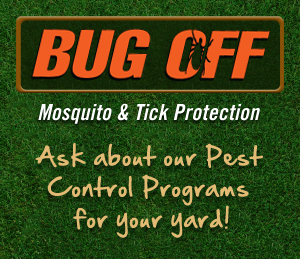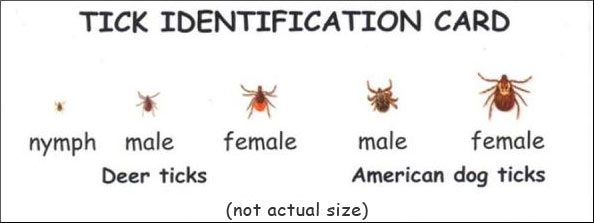Frequently Asked Questions
Back to Full Service Maintenance
Is it safe? All of our insecticides are regulated by the EPA. We inform customers that there is no more risk than applying pesticides that are commonly used to treat your lawn during a fertilization application. However, if you ever have questions or concerns, please feel free to contact us! We also offer an Organic alternative.
Does it really work? Yes, it really does. Our customer list has steadily increased each year since incorporation of the service several years ago. We have found that in most cases you can see a difference after just one treatment. However, for mosquitoes, we do recommend at least two treatments before you experience a significant reduction in the mosquito population.
How long does each treatment last? Season-long control, April through September. Treatments are done approximately every 3 weeks for a total of 8 treatments per season.
Where are the treatment areas? We treat areas most frequently used by people such as around decks, play areas, pools, patios and along the wood lines creating a vertical barrier around your property.
Does the rain wash it away? As with any product that is diluted with water, it will become less effective with heavy rain. However, we do add a "sticker" agent to the mixture that causes the product to stick to the foliage and thus reduce the odds of the product washing away.
How long do I wait until going back into the yard? We recommend waiting until the treatment dries. Drying time may be as little as 10 minutes when the weather permits.
Deer Ticks & Lyme Disease Facts
Lyme Disease is an infection caused by Borrelia Burgdorferi, a type of bacterium called Spirochete.
First Recognized in 1975, when an unusually large number of cases of Juvenile Arthritis occurred in the town of Lyme, CT. In some cases they were known to have had a tick bite, followed by a rash at the site of the bite.
The Deer Tick has a two-year life cycle that includes three blood-feeding stages known as larva, nymph and adult. When ticks are born, the larva stage, they are not born with Lyme Disease. Both nymph and adult stage ticks will bite and feed on a human host. Generally, larvae and nymphs feed on small animals, such as a field mouse, chipmunk or bird. If any of these small animals are infected, then the disease is then transmitted to the tick. Adult ticks will then dine on larger mammals such as the white-tailed deer and humans, as well. Contrary to its name, by the time the deer tick lands on a deer, the tick is already infected with the disease. The deer does not cause the tick to become infected. The deer only serves as a blood meal or host. Also, the American Dog Tick has not been known to transmit Lyme Disease; but can transmit other diseases such as Rocky Mountain Spotted Fever and Tularemia.
The Risk Period for humans is highest during the nymph stage from May through July. The nymph is about the size of a poppy seed and can be very difficult to detect. Adult ticks, the size of about a sesame seed, may also be infected and are typically more active from Fall to Spring, whenever the temperature is above 45 degrees.
Tick Habitat is near the ground within a wooded area, gardens and plants, hedges, stone walls and leaf litter. Ticks prefer shade and moisture. You will also find ticks on your pets, near wood piles and around bird feeders. You will most likely not encounter a tick in open sunny areas such as your lawn. However, adult ticks are known to have fallen from their host almost anywhere after they have finished feeding.
Symptoms of tick bites can vary. A rash often described as a "bull's eye rash" is very common and is usually the first symptom, 70-80% of cases start with the this type of rash. It appears between 3 and 30 days after the bite. An individual may also experience flu-like systems, arthritis, neurological and heart problems. If you suspect a tick bite or have systems, see your Dr. immediately.
Keys to Prevention: Perform daily checks on yourself, children and pets. Wear light colored, long sleeved protective clothing while in the yard. Use repellents that contain DEET. Stick to main pathways while hiking. Treat your clothing with Permethrin. Remove a tick from your skin with tweezers and keep it in a jar so it can be tested for Lyme disease should you start getting any symptoms. Ticks need to be attached for at least 24 hours before they transmit LD.
Reduce ticks around your house by keeping your grass short, remove leaf litter, discourage and reduce the deer and rodent population, keep bird feeders and wood piles away from your home, create a buffer zone between woods edge and family activity areas. Incorporate a "Tick Protection Plan" for your property by contacting Motta Landscaping, Inc.
Mosquitoes & Disease Facts
Diseases spread by the mosquito include West Nile Virus, EEE (Eastern Equine Encephalitis) , malaria, yellow fever, dog heartworm and many others. Worldwide, mosquito-borne diseases kill more people than any other single factor.
First Originated in Africa and then spread throughout the tropics. There are over 170 known species from North America alone, 3,000 worldwide. A female can live between 3-100 days. The male only lives for 10-20 days.
The Mosquito has a four stage life cycle which is egg, larva, pupa and adult. The first three stages are aquatic and can last 1-2 weeks. The adult will emerge from the pupa, float to the surface of water and fly away. Once an adult, they begin feeding immediately. Males do not feed on blood but instead feed on nectar and plant liquids containing sugar. The female requires a "blood meal" in order to develop her eggs. Mosquitoes do not feed on blood. Both feed on nectar, juices, decaying matter and sugar from plants, which is burned as fuel.
The Risk Period for humans begins when the temperature is above 50 degrees F. Mosquitoes are cold blooded and will enter hibernation in order to survive the cold. Mosquitoes hunt by infrared emissions from warm-blooded animals, which is a whole lot easier when the air temperature is cooler than the animal's or human's body temperature. This is why they come out at dusk when the temperature isn't too hot but is lower than their prey's body temperature. From 100 feet mosquitoes can smell our scent, especially the carbon dioxide (CO2) that we breathe out. Mosquitoes cannot see you until about 30 feet away. At 10 feet away, they use sensitive thermal receptors on the tip of their antennae to locate the blood near the surface of your skin. Humidity will increase the range of the receptors. Some people are more attractive to mosquitoes than others. It is not clear why, but very well could be the 300 or so chemicals produced by the skin. They are attracted to scents like perfumes, sweat, body odor, soaps and heat.
Mosquito Habitat includes almost any standing body of water imaginable; including discarded containers, old tires, bird baths, wetlands, holes in trees, salt marshes, irrigation ditches, etc. The larvae feed on organic particles found in the water. Adult females will later lay her eggs in perhaps the same body of water. Mosquitoes will bite people when they get the chance. However, they are better at tracking the scent of animals that are most abundant in their habitat.
Symptoms of the most common diseases caused my mosquitoes in our area (West Nile Virus and EEE) can include, to mention a few, abdominal pain, fever, flu like symptoms, vomiting, muscle weakness, loss of consciousness, clumsiness, confusion and stiff neck.
Keys to Prevention: Perform daily checks on yourself, children and pets. Wear light colored, long sleeved protective clothing while in the yard. Use repellents that contain DEET. Try to perform your outdoor activities before dusk.
Reduce Mosquitoes around your house by empting containers of water, remove leaf litter, discourage and reduce the deer and rodent population, keep bird feeders clean with fresh water on a regular basis and create a buffer zone between woods edge and family activity areas by incorporating a "Mosquito Protection Plan" for your property by contacting Motta Landscaping, Inc.
Lyme Disease Information – http://cdc.gov/lyme
Ticks & Entomology Information – http://www.capecodextension.org
The Motta Difference.

